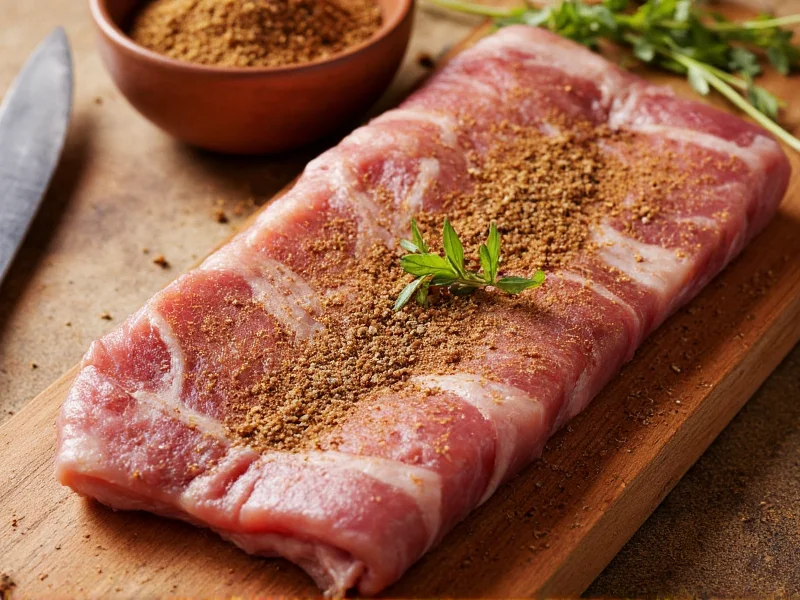Understanding which spices work best with pork transforms ordinary dishes into culinary masterpieces. Pork's mild flavor and fat content provide the perfect canvas for diverse spice combinations, but selecting the right blend requires knowledge of flavor chemistry and cooking techniques.
Why Certain Spices Complement Pork Perfectly
Pork contains natural sugars that caramelize beautifully when cooked, creating a flavor profile that responds exceptionally well to both sweet and savory spices. The fat content in pork acts as a flavor carrier, allowing spices to penetrate deeply during cooking. Understanding this interaction helps you select spices that enhance rather than overwhelm pork's natural characteristics.
Essential Spice Categories for Pork Dishes
Successful pork seasoning falls into three primary categories that work synergistically:
| Spice Category | Key Examples | Best Pork Applications |
|---|---|---|
| Herbal & Earthy | Sage, rosemary, thyme, oregano | Pork loin, chops, tenderloin |
| Warm & Pungent | Garlic, onion, black pepper, mustard | All cuts, especially roasts |
| Sweet & Smoky | Paprika, cumin, coriander, allspice | Shoulder, ribs, belly |
Regional Spice Traditions for Pork Preparation
Cultures worldwide have developed distinctive spice approaches for pork based on local ingredients and cooking methods:
- Mediterranean approach: Combines rosemary, garlic, lemon zest, and olive oil for grilled pork chops and tenderloin
- Asian fusion: Uses five-spice powder (star anise, cloves, Chinese cinnamon, Sichuan pepper, fennel seeds) with ginger and soy for pork belly
- Mexican tradition: Features chili powder, cumin, oregano, and citrus in adobo rubs for carnitas and pulled pork
- Southern barbecue: Relies on paprika-based rubs with brown sugar, garlic powder, and cayenne for ribs and shoulder
Creating Perfect Spice Rubs for Different Pork Cuts
The ideal spice blend varies significantly based on the pork cut you're preparing. Fattier cuts like shoulder can handle bolder spices, while leaner cuts like tenderloin benefit from more delicate combinations.
For pork shoulder (ideal for pulled pork), combine:
- 2 tablespoons smoked paprika
- 1 tablespoon garlic powder
- 1 tablespoon onion powder
- 2 teaspoons cumin
- 2 teaspoons brown sugar
- 1 teaspoon cayenne (optional)
- Salt to taste
Apply this dry rub generously 12-24 hours before cooking to allow flavors to penetrate the meat. The sugar content helps create a beautiful crust during slow cooking while the spices infuse throughout.
Timing Matters: When to Apply Spices to Pork
The timing of spice application dramatically affects flavor development:
- Dry rubs: Apply 12-48 hours before cooking for maximum flavor penetration, especially for larger cuts
- Wet marinades: Use for 4-12 hours (never超过24 hours as acid can start to "cook" the meat)
- Finishing spices: Add delicate herbs like fresh basil or cilantro during the last 15 minutes of cooking
Professional chefs often use a two-stage approach: applying foundational spices early and finishing with brighter, more volatile flavors just before serving. This technique creates complex flavor layers that single-application methods cannot achieve.
Avoiding Common Spice Application Mistakes
Even with the best spices, improper application can ruin your pork dish. Watch for these common errors:
- Over-salting: Many spice blends already contain salt—check ingredients before adding extra
- Burning spices: High-heat cooking can burn delicate spices—add them later in the cooking process
- Ignoring acid balance: Spices need acidic components to shine—add citrus or vinegar to brighten flavors
- Uneven distribution: Press spices firmly into the meat surface for better adhesion and flavor penetration
Remember that pork's fat content works as a flavor carrier, so properly applied spices will distribute throughout the meat during cooking. This is why professional chefs often score the fat cap on pork roasts—to create channels for spice penetration.
Experimenting with Unique Spice Combinations
Once you master basic pork seasoning, try these innovative combinations that push flavor boundaries while remaining balanced:
- Coffee-chili rub: Ground coffee, ancho chili powder, garlic, and brown sugar for smoked pork shoulder
- Apple-fennel blend: Fennel seeds, dried apple pieces, mustard powder, and thyme for pork chops
- Miso-umami boost: White miso paste, ginger, garlic, and a touch of honey for Asian-inspired pork belly
When experimenting with new spice combinations for pork loin recipes or other cuts, start with small batches to test flavor balance before committing to larger quantities. Keep notes on successful blends for future reference—this builds your personal spice knowledge base over time.











 浙公网安备
33010002000092号
浙公网安备
33010002000092号 浙B2-20120091-4
浙B2-20120091-4